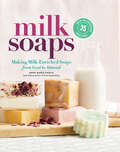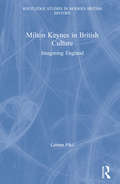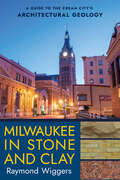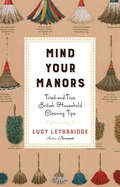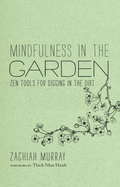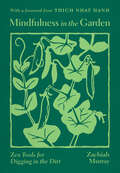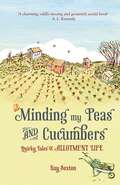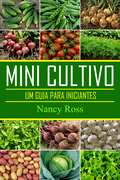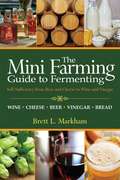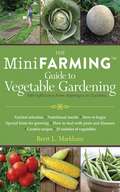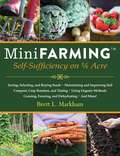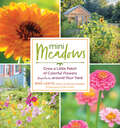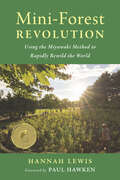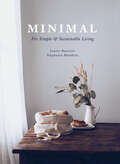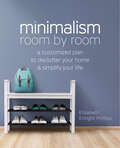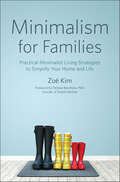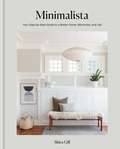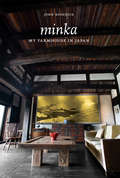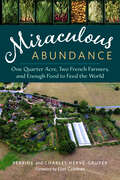- Table View
- List View
Milk Soaps: 35 Skin-Nourishing Recipes for Making Milk-Enriched Soaps, from Goat to Almond
by Anne-Marie FaiolaHandmade soap is made extra-special with the addition of milk! Soaps enriched with milk are creamier than those made with water, and milk’s natural oils provide skin-renewing moisture and nourishment. In Milk Soaps, expert soapmaker Anne-Marie Faiola demystifies the process with step-by-step techniques and 35 recipes for making soaps that are both beautiful and useful. She explains the keys to success in using a wide range of milk types, including cow, goat, and even camel milk, along with nut and grain milks such as almond, coconut, hemp, rice, and more. Photographs show soapmakers of all levels how to achieve a variety of distinctive color and shape effects, including funnels, swirls, layers, and insets. For beginners and experts alike, this focused guide to making milk-enriched soaps offers an opportunity to expand their soapmaking skills in new and exciting ways. This publication conforms to the EPUB Accessibility specification at WCAG 2.0 Level AA.
Milk-Based Soaps: Making Natural, Skin-Nourishing Soap
by Casey MakelaCraft beautiful, sweet-smelling milk-based soaps safely and easily. In this fun and informative guide, Casey Makela shares her specialized techniques for producing lusciously creamy soaps. With straightforward instructions and thorough explanations, Makela teaches you how to fashion your own soaps from vegetable oils and tallow bases, giving dozens of suggestions for relaxing scents and specialty colors that will let your product shine. You’ll soon be creating enticingly unique soaps that will keep your glowing skin smelling and feeling good all day.
Milton Keynes in British Culture: Imagining England (Routledge Studies in Modern British History)
by Lauren PikóThe new town of Milton Keynes was designated in 1967 with a bold, flexible social vision to impose "no fixed conception of how people ought to live." Despite this progressive social vision, and its low density, flexible, green urban design, the town has been consistently represented in British media, political rhetoric and popular culture negatively. as a fundamentally sterile, paternalistic, concrete imposition on the landscape, as a "joke", and even as "Los Angeles in Buckinghamshire". How did these meanings develop at such odds from residents' and planners' experiences? Why have these meanings proved so resilient? Milton Keynes in British Culture traces the representations of Milton Keynes in British national media, political rhetoric and popular culture in detail from 1967 to 1992, demonstrating how the town's founding principles came to be understood as symbolic of the worst excesses of a postwar state planning system which was falling from favour. Combining approaches from urban planning history, cultural history and cultural studies, political economy and heritage studies, the book maps the ways in which Milton Keynes' newness formed an existential challenge to ideals of English landscapes as receptacles of tradition and closed, fixed national identities. Far from being a marginal, "foreign" and atypical town, the book demonstrates how the changing political fortunes of state urban planned spaces were a key site of conflict around ideas of how the British state should function, how its landscapes should look, and who they should be for.
Milwaukee in Stone and Clay: A Guide to the Cream City's Architectural Geology
by Raymond WiggersMilwaukee in Stone and Clay follows directly in the footsteps of Raymond Wiggers's previous award-winning book, Chicago in Stone and Clay. It offers a wide-ranging look at the fascinating geology found in the building materials of Milwaukee County's architectural landmarks. And it reveals the intriguing and often surprising links between science, art, and engineering. Laid out in two main sections, the book first introduces the reader to the fundamentals of Milwaukee's geology and its amazing prehuman history, then provides a site-by-site tour guide. Written in an engaging, informal style, this work presents the first in-depth exploration of the interplay among the region's most architecturally significant sites, the materials they're made of, and the sediments and bedrock they're anchored in. Raymond Wiggers crafted Milwaukee in Stone and Clay as an informative and exciting overview of this city. His two decades of experience leading architectural-geology tours have demonstrated the popularity of this approach and the subject matter.
Mind Your Manors: Tried-and-True British Household Cleaning Tips
by Lucy LethbridgeThe author of Servants tells us what made British households, of all sizes, shine. British estates were known to be the epitome of cleanliness with their white-glove perfection. Through her meticulous research on servants, Lucy Lethbridge gleaned much knowledge about how these homes were made to gleam over almost two centuries, from the Victorian through the Edwardian years and beyond. The majority of household tasks were done with basic ingredients like lemon juice, white vinegar, and bicarbonate of soda, which feel very modern in their display of frugality and ecological soundness. Tea leaves were used to freshen up rugs and stewed rhubarb to remove rust stains. Here, Lethbridge reveals these old-fashioned and almost-forgotten techniques that made British households sparkle before the use of complicated contraptions and a spray for every surface. A treasury of advice from servants' memoirs and housekeeping guides, and illustrated with charming art from period advertising and domestic classics, Mind Your Manors is the perfect book for all those who want to put time-tested cleaning methods to work.
Mindfulness in the Garden: Zen Tools for Digging in the Dirt
by Zachiah MurrayMindfulness in the Garden offers simple mindfulness verses (gathas) composed to connect the mind and body and to bring the reader/gardener's awareness to the details of the present moment as they work in the garden. These gathas are signposts leading to nature, to the present, and ultimately to one's self through the love and understanding they evoke. The gathas offered with each gardening activity serves to water the seeds of mindfulness within us, and softening and preparing the ground for our ability to be present.Mindfulness in the Garden values weeds as important messengers seeking to bring into close communion our spiritual nature with that of the environment. It likens spiritual practice to cultivating a garden and inspires each person to accept themselves and start where they are, weeds and all. Through the practice of mindful gardening, we invite not only the thriving of the natural world but also the flowering and beauty of the pure land of our true self to emerge.Features black and white botanical illustrations throughout.Introduction by Thich Nhat Hanh, author of Present Moment Wonderful MomentForeword by Wendy Johnson,author of Gardening at the Dragon's Gate
Mindfulness in the Garden: Zen Tools for Digging in the Dirt
by Zachiah MurrayMindfulness in the Garden offers simple mindfulness verses (gathas) composed to connect the mind and body and to bring the reader/gardener&’s awareness to the details of the present moment as they work in the garden. These gathas are signposts leading to nature, to the present, and ultimately to one&’s self through the love and understanding they evoke. The gathas offered with each gardening activity serves to water the seeds of mindfulness within us, and to soften and prepare the ground for our ability to be present.Mindfulness in the Garden values weeds as important messengers seeking to bring into close communion our spiritual nature with that of the environment. It likens spiritual practice to cultivating a garden and inspires each person to accept themselves and start where they are, weeds and all. Through the practice of mindful gardening, we invite not only the thriving of the natural world but also the flowering and beauty of the pure land of our true self to emerge.Features black and white botanical illustrations throughout.Foreword by Zen Master Thich Nhat Hanh, author of Present Moment, Wonderful MomentNew Afterword by Mick McEvoy, manager of Plum Village Happy Farm in France
Minding My Peas and Cucumbers: Quirky Tales of Allotment Life
by Kay SextonWhen Kay Sexton becomes the proud holder of an allotment, she hopes it will be her first foray towards self-sufficiency. Instead, she finds herself in a strange and hostile world of arcane rules and regulations, and hosepipe standoffs. Witty, well-observed and with mouth-watering recipes, this book is for anyone who dreams of the good life.
Mini Case Guida per Principianti alla Vita in una Mini Casa
by Nancy Ross Elisa StucchiVolete scoprire come progettare in modo facile la vostra mini casa e vivere felicemente al suo interno? Se siete alla ricerca di consigli su come costruirla, idee su come organizzarla, o non sapete ancora se una mini casa fa per voi, questo libro vi aiuterà. Ecco un’anteprima di cosa troverete all'interno: I lati positivi delle mini case I modi di finanziare la vostra mini casa Trovare la posizione perfetta Semplici trucchi per avere più spazio e vivere meglio Idee per la cucina Design di soggiorno, bagno e camera da letto Idee e trucchi per vivere bene in una mini casa E molto, molto altro!
Mini Cultivo - Um Guia Para Iniciantes
by Nancy Ross Combo TranslationsVocê quer aprender os conceitos básicos de mini cultivo? Se você quer aprender mini cultivo para jardinagem, pecuária, ou auto suficiência este livro vai ajudar! Aqui está uma prévia do que você vai aprender ... Truques simples para maximizar seu espaço Melhores Plantas para mini cultivo Escolhendo o solo certo Controle de pragas Cuidar das ervas daninhas Pecuária que faz bem com mini cultivo? Dicas para tornar o mini cultivo mais fácil Muito, muito, mais!
Mini Farming Guide to Fermenting: Self-Sufficiency from Beer and Cheese to Wine and Vinegar
by Brett L. MarkhamBrett Markham, author of Mini Farming: Self-Sufficiency on ¼ Acre, explains how to ferment just about anything you can grow, and reminds us that gourmet cheeses, fancy vinegars, and store-bought wines can be expensive--making your own can not only be fun but will save money. Learn to make sourdough or experiment with making wine using a countertop juice machine. Inside you'll find recipes and instructions with checklists, extensive tables, measurements, and 150 of the author's own photographs.
Mini Farming Guide to Vegetable Gardening: Self-Sufficiency from Asparagus to Zucchini
by Brett L. MarkhamMake the most of your vegetable garden with Brett Markham, author Mini Farming: Self-Sufficiency on ¼ Acre. This comprehensive new handbook covers everything you need to know about maximizing and harvesting the best vegetables you can possibly produce. With each chapter addressing a different vegetable, you'll learn tips and tricks about varietal selection, nutritional merits, how to begin, special hints for growing, and how to deal with particular pests and diseases, plus one or two creative recipes to get you started. With over 150 of Markham's own photographs guiding you every step of the way, you'll find this an honest, straightforward guide and a must-have for any vegetable mini-farmer.
Mini Farming: Self-Sufficiency on 1/4 Acre
by Brett L. MarkhamMini Farming describes a holistic approach to small-area farming that will show you how to produce 85 percent of an average family's food on just a quarter acre--and earn $10,000 in cash annually while spending less than half the time that an ordinary job would require. Even if you have never been a farmer or a gardener, this book covers everything you need to know to get started: buying and saving seeds, starting seedlings, establishing raised beds, soil fertility practices, composting, dealing with pest and disease problems, crop rotation, farm planning, and much more. Because self-suf?ciency is the objective, subjects such as raising backyard chickens and home canning are also covered along with numerous methods for keeping costs down and production high. Materials, tools, and techniques are detailed with photographs, tables, diagrams, and illustrations.
Mini Meadows: Grow a Little Patch of Colorful Flowers Anywhere around Your Yard
by Mike LizotteThe word “meadow” conjures images of wide expanses of land, but a mini meadow — a kind of informal flower garden started with seed sown directly into the soil — can be any size; plus, it’s fun, easy to grow, and good for the planet. With as little as 50 square feet and for less than $20, gardeners can plant a colorful meadow that demands little in the way of space, mowing, or maintenance, uses less water than a traditional lawn, and provides habitat for pollinators — not to mention a natural exploration space for children. From choosing the right variety of seeds, preparing the soil, sowing evenly, and watering well, author Mike Lizotte guides readers through the process of successfully creating a miniature meadow that suits their climate, soil, and growing goals, whether planting to beautify a hellstrip, halt erosion, fill a boggy spot, or establish a nesting area for bees and butterflies. Mini Meadows offers gardeners of all levels the keys to creating, caring for, and reaping the rewards of thriving meadows through the seasons, year after year. This publication conforms to the EPUB Accessibility specification at WCAG 2.0 Level AA.
Mini-Forest Revolution: Using the Miyawaki Method to Rapidly Rewild the World
by Hannah Lewis*2023 Nautilus Book Award Gold Medal Winner: Green, Restorative Practices /Sustainability&“Hannah Lewis describes a gift to a despairing world. . . . There may be no single climate solution that has a greater breadth of benefits than mini-forests. . . [and] can be done by everyone everywhere.&”—Paul Hawken, from the forewordFor readers who enjoyed Finding the Mother Tree and The Hidden Life of Trees comes the first-ever book about a movement to restore biodiversity in our cities and towns by transforming empty lots, backyards, and degraded land into mini-forests. Author Hannah Lewis is the forest maker turning asphalt into ecosystems to save the planet and she wants everyone to know they can do it too.In Mini-Forest Revolution, Lewis presents the Miyawaki Method, a unique approach to reforestation devised by Japanese botanist Akira Miyawaki. She explains how tiny forests as small as six parking spaces grow quickly and are much more biodiverse than those planted by conventional methods. She explores the science behind why Miyawaki-style mini-forests work and the myriad environmental benefits, including: cooling urban heat islands, establishing wildlife corridors, building soil health, sequestering carbon, creating pollinator habitats, and more.Today, the Miyawaki Method is witnessing a worldwide surge in popularity. Lewis shares the stories of mini-forests that have sprung up across the globe and the people who are planting them―from a young forest along the concrete alley of the Beirut River in Lebanon, to a backyard forest planted by tiny-forest champion Shubhendu Sharma in India.This inspiring book offers a revolutionary approach to planting trees and a truly accessible solution to the climate crisis that can be implemented by communities, classrooms, cities, clubs, and families everywhere. &“Lewis simplifies the science of planting trees in a manner that produces the maximum benefit.&”—The Associated Press
Minimal: For Simple and Sustainable Living
by Stéphanie Mandrea Laurie BarretteA stylish and inspiring guide to living a happier life in balance with the natural world Minimal offers readers inspiration and tools to embrace simple living and create meaningful, lasting change in their lives. From advice on home decorating and decluttering, and easy-to-follow recipes for making your own cosmetics and cleaning products, to tips for shopping sustainably, composting, and restoring old furniture, Minimal provides a host of small but powerful ways to live a more balanced life while being good to the planet.
Minimal: How to simplify your life and live sustainably
by Madeleine OliviaLove yourself. Love the planet. We are facing an urgent climate crisis and we must all take action now. However, it can be difficult to know where to start when bombarded with overwhelming facts and statistics every day. We all want to make a difference, but what can we do? Minimal makes simple and sustainable living attainable for everyone, using practical tips for all areas of everyday life to reduce your impact on the earth. Leading environmentalist Madeleine Olivia shares her insights on how to care for yourself in a more eco-friendly way, as well as how to introduce a mindful approach to your habits. This includes how to declutter your life, reduce your waste and consumption, recipes for eating seasonally and making your own natural beauty and cleaning products. Learn how to minimise the areas that aren’t giving you anything back and discover a happier and more fulfilled life, while looking after the Earth we share.
Minimalism Room by Room: A Customized Plan to Declutter Your Home and Simplify Your Life
by Elizabeth Enright PhillipsDiscover the beauty of less and focus on what really matters The minimalist lifestyle promotes peace and intentionality through the act of decluttering. This indispensable manual uses inspiration, positive reinforcement, and an efficient room-by-room guide to lead you from cluttered living to clarity of purpose. What sets this book apart: The fundamentals of minimalism—This life-changing how-to book illuminates the principles and benefits of minimalism, and provides a blueprint for realizing a less stressful life by prioritizing relationships over objects. Simple steps to declutter—With easy, actionable strategies, Minimalism Room by Room eases you into the process of eliminating the excess, so tidying up is a manageable and rewarding experience. Tips and resources—This book provides organization tools to make embracing minimalism easier, such as checklists, sorting guides, and guidance to help get past inevitable emotional and physical obstacles. Learn to live a life of purpose and calm by owning less and appreciating more with Minimalism Room by Room.
Minimalism for Families: Practical Minimalist Living Strategies to Simplify Your Home and Life
by Zoë KimShare the joys of minimalism with your whole family.Make room for what really matters. Minimalism for Families shows you the real costs of the things you own and helps you discover that cutting non-essential items makes for a happier, more satisfying home and life.Spend less time stressing about your stuff and more time together. Filled with practical advice to help you and your family clear out your house, Minimalism for Families helps you build stronger bonds, spend more time together, and start enjoying the benefits of living clutter-free.Minimalism for Families includes:An introduction to minimalism—Find out what minimalism really is and how it can make for a happier household.A family approach—Discover how to handle family resistance and get everyone—including your children—to embrace minimalism.Practical, room-by-room advice—From the kitchen to kids' rooms, get easy-to-use tips for creating and keeping a simple home.Bring the benefits of minimalism to your loved ones with Minimalism for Families.
Minimalismo: Simplifica tu vida
by Moisés Moreno Costilla Samanta R. RodriguesEn este libro, se alienta al lector a adoptar un estilo de vida minimalista. Se ofrecen los pasos para que el lector o lectora pueda adaptarse para vivir una vida plena, sin los excesos que caracterizan a la sociedad moderna. Se trata de obtener confort con menos cosas, y de hacer más con esas cosas. A lo largo del libro, te daremos consejos sobre cómo adoptar el estilo de vida minimalista. Para que todo esto ocurra, es necesario saber cuáles son nuestras metas y nuestros sueños. Esos objetivos pueden ser el impulso que faltaba para proyectarnos en dirección al minimalismo. Una vez que adoptar los consejos de este libro, podrás librarte de las cosas que no hacen sentido en tu vida, como las cosas que acumulas en casa. Entonces, podrás escoger aquello que dejarás entrar en tu vida y también lo que no podrá entrar.
Minimalist Moms: Living and Parenting with Simplicity
by Diane BodenA &“practical and inspirational&” collection of minimalist quotes, daily wisdom, affirmations, and meditations to keep you focused on the joy of simplicity (Morgan Tyree, author of Take Back Your Time). If your goal is more time, more space, and more inner calm, you don&’t want a book that&’s a chore to read. As a busy, overwhelmed mom, you&’ve got enough chores already. So this inspiring little gem from popular podcaster Diane Boden offers something better: quick daily quotes, meditations, and affirmations that provide a reminder of the positive impact of minimalism. This book understands that minimalism is more of a way of life than a goal to be reached—a habit of simple living, focusing on what matters, and maintaining a peaceful mind. A perfect, gentle guide to getting started, it helps you aspire toward minimalism and simplify your life and home. Practical advice on how to live a minimalist lifestyle emotionally, physically, and mentally Mantras that cover a range of topics, from slowing down and getting outside to habit stacking and decluttering Accessible minimalism that is applicable to any lifestyle—and any busy mother
Minimalista: Your Step-by-Step Guide to a Better Home, Wardrobe, and Life
by Shira GillElevate your personal style, trim your belongings, and transform your life, one room at a time, with this visionary lifestyle and home organization book from professional organizing expert, Shira Gill.&“Warm, funny, and direct, Shira builds you up while helping you edit down to the best version of yourself.&”—Stacy London, New York Times bestselling author of The Truth About StyleAs a professional home organizer with clients ranging from students to multi-millionaires, Shira Gill observed that clutter is a universal stress trigger. Over the years she created a signature decluttering and organization process that promotes sustainability, achieves lasting results, and can be applied to anyone, regardless of their space or lifestyle. Rather than imposing strict rules and limitations, Shira redefines minimalism as having the perfect amount of everything—for you—based on your personal values and the limitations of your space. Now, in Minimalista, Shira shares her complete toolkit for the first time, built around five key steps: Clarify, Edit, Organize, Elevate, and Maintain. Once you learn the methodology you'll dive into the hands-on work, choose-your-own-adventure style: knock out a room, or even a single drawer; style a bookshelf; donate a sweater. Shira teaches that the most important thing you can do is start, and that small victories, achieved one at a time, will snowball into massive transformation. Broken into small, bite-sized chunks, Minimalista makes it clear that if the process is fun and easy to follow, anyone can learn the principles of editing and organization.
Minimalista: Your step-by-step guide to a better home, wardrobe and life
by Shira Gill***"I identified with so many of the important lessons Shira teaches in Minimalista. Now I'll know what book to recommend when people ask me to help them on their journey towards minimalism!" - Garance Doré, New York Times Best Selling Author of Love Style LifeElevate your personal style, trim your belongings, and transform your life, one room at a time, with this visionary lifestyle and home organisation book from organising expert, Shira Gill.As a professional home organiser with clients ranging from students to multi-millionaires, Shira Gill observed that clutter is a universal stress trigger. Over the years she created a signature decluttering and organisation process that promotes sustainability, achieves lasting results, and can be applied to anyone, regardless of their space or lifestyle. Rather than imposing strict rules and limitations, Shira redefines minimalism as having the perfect amount of everything - for you - based on your personal values and the limitations of your space. Now, in Minimalista, Shira shares her complete toolkit for the first time, built around five key steps: Clarify, Edit, Organize, Elevate, and Maintain. Shira teaches that the most important thing you can do is start, and that small victories, achieved one at a time, will snowball into massive transformation. Broken into small, bite-sized chunks, Minimalista makes it clear that if the process is fun and easy to follow, anyone can learn the principles of editing and organisation.The Minimalista Manifesto· Buy less; live more.· Invest in high quality + solid craftsmanship.· Opt for natural, sustainable materials.· Treat your space + your stuff with respect.· Shop your own home before hitting the stores.· Celebrate life's little luxuries: fresh flowers, hot water, a good meal with friends.· Try to repair instead of replace.· Embrace negative space and dispose of unwanted items responsibly.· Create a home that supports your personal goals + core values.· Be the gatekeeper of your home.· Say "no" to swag, freebies, and hotel samples.· Say "no" to excess and "yes" to enough.
Minka: My Farmhouse in Japan
by John RoderickIn 1959 journalist John Roderick joined the Tokyo bureau of the Associated Press. There, he befriended a Japanese family, the Takishitas. After musing offhandedly that he would like to one day have his own house in Japan, the family—unbeknownst to John—set out to grant his wish. They found Roderick a 250-year-old minka, or hand-built farmhouse, with a thatched roof and held together entirely by wooden pegs and joinery. It was about to be washed away by flooding and was being offered for only fourteen dollars. Roderick graciously bought the house, but was privately dismayed at the prospect of living in this enormous old relic lacking heating, bathing, plumbing, and proper kitchen facilities. So the minka was dismantled and stored, where Roderick secretly hoped it would stay, as it did for several years. But Roderick's reverence for natural materials and his appreciation of traditional Japanese and Shinto craftsmanship eventually got the better of him. Before long a team of experienced carpenters were hoisting massive beams, laying wide wooden floors, and attaching the split-bamboo ceiling. In just forty days they rebuilt the house on a hill overlooking Kamakura, the ancient capital of Japan. Working together, they renovated the farmhouse, adding features such as floor-to-ceiling sliding glass doors and a modern kitchen, bath, and toilet. From these humble beginnings, Roderick's minka has become internationally known and has hosted such luminaries as President George H. W. Bush, and Senator Hillary Clinton. John Roderick's architectural memoir Minka tells the compelling and often poignant story of how one man fell in love with the people, culture, and ancient building traditions of Japan, and reminds us all about the importance of craftsmanship and the meaning of place and home in the process.
Miraculous Abundance: One Quarter Acre, Two French Farmers, and Enough Food to Feed the World
by Perrine Herve-Gruyer Charles Herve-Gruyer&“Farmers like Charles and Perrine Hervé-Gruyer [are] beacons of light. Their work allows the rest of the world to see that there is another life, there is another way.&”—Eliot ColemanWhat began as a simple dream has turned into one of the world&’s most radical, innovative experiments in small-scale farming—using the Bec Hellouin model for growing food, sequestering carbon, creating jobs, and increasing biodiversity without using fossil fuelsWhen Charles and Perrine Hervé-Gruyer set out to create their farm in a historic Normandy village, they had no idea just how much their lives would change. Neither one had ever farmed before. Charles had been traveling the globe teaching students about ecology and indigenous cultures. Perrine had been an international lawyer in Japan. Their farm Bec Hellouin has since become an internationally celebrated model of innovation in ecological agriculture. Miraculous Abundance is the eloquent tale of the couple&’s quest to build an agricultural model that can carry us into a post-carbon future.The authors dive deeper into the various farming methods across the globe that contributed towards the creation of the Bec Hellouin model, including:Permaculture and soil health principlesKorean natural farming methodsManaging a four-season farmCreating a productive agroecosystem that is resilient and durableUsing no-dig methods for soil fertilityModelling an agrarian system that supports its community in totality; from craft, restaurants and shared work spaces to jobs, agritourism, energy and ecological biodiversityPerfect for aspiring and experienced farmers, gardeners, and homesteaders, Miraculous Abundance is a love letter to a future where ecological farming is at the centre of every community. &“This book, more about philosophy than a how-to, describes how two inexperienced beginners succeeded in creating a gorgeous, productive, self-sustaining farm.&”—Marion Nestle
